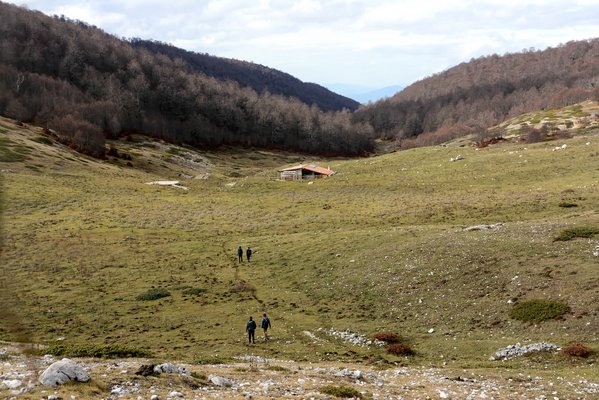By Sophie Monsarrat
It is 6h30 in the morning when two wolves emerge from their sleep in the Abruzzo, Lazio e Molise National Park in the Central Apennines region, Italy. Eight of us are watching in perfect silence, as we sit still on a hill some 200m away. We detected their presence using a night vision lens and are now following their movements with our binoculars. As they move towards us, we anticipate the moment they might pass right beside our hiding place, but they take a left turn instead, and disappear out of sight. The observation lasted only ten minutes, but is imprinted in our mind as one of these moments suspended in time, where wild nature can act unbothered by our human presence.
It is November 2021, and we – five postdocs and one assistant professor from BIOCHANGE– are visiting the Central Apennines rewilding site, one of the nine European sites supervised by the organization Rewilding Europe. We are here to learn how rewilding – an ecosystem restoration strategy focused on restoring natural processes and keystone species – happens in practice.

When the theoretical basis for rewilding was first established in the late 1990’s, Michael Soulé and Reed Noss identified the three C’s – Core, Corridor, Carnivore – as key components for successful ecosystem restoration. This made sense in a North American context, where large National Parks excluding most human activities were historically set aside for nature, at the cost of local communities’ livelihoods. In contemporary Europe where this divide is no longer possible – nor desirable – another C emerges as a cornerstone of rewilding: Coexistence.
As we are about to learn during this week, coexistence is a hard-earned prize in areas where large carnivores roam cultural landscapes. Wolves and endemic Marsican bears are found in relatively high densities in the Central Apennines, one of the few places in Europe where they did not disappear historically. Today, the recent history of rural depopulation and land abandonment in the region appears as an opportunity to support the recovery of these large animals and the restoration of natural processes. But focusing on restoring keystone species while ignoring the tensions with human populations still inhabiting the land would be a mistake. Local communities often bear the costs of living with predators without reaping the economic and social benefits that these animals can bring. For wildlife to flourish in these areas, local acceptance must be built through supporting local livelihoods and establishing relationships of trust between practitioners and stakeholders, highlighting the mutual benefits that can arise from coexistence.
Focusing their activities on corridor areas connecting existing protected areas, the Rewilding Apennines team does just that. They focus on monitoring wildlife and improving the quality of their habitat, preventing and mitigating human-wildlife conflicts and building links within the local community to promote rewilding as an alternative economic model. Their vision is one of wildness where human activities respectful of the environment exist alongside wild animals and natural processes, in a shared space. What we learned from our visit here is that this vision requires compromises – not every activity will be beneficial for biodiversity, and tension will continue to arise from coexistence with large animals. However, it is a useful trajectory to guide decision-making; one that encourages more sustainable practices than current models of development and inspires more pragmatic management strategies than classic visions of conservation excluding humans from nature. The future will tell if the model promoted by Rewilding Apennines can succeed in achieving the right balance between human activities and ecosystem recovery in this area. Still, in this time of environmental crises and societal turmoil, every step in the right direction matters.
On our last night, one of our guides admitted that his hope is that increased coexistence will evoke an innate connection with nature and encourage people to respect and value their wild backyard. There is diversity in humans’ attitude towards wildlife, and a long way to go before large predators are widely accepted as part of European cultural landscapes. Yet, the raw emotion we felt while observing these two wolves on a foggy morning was certainly evocative of this hope.